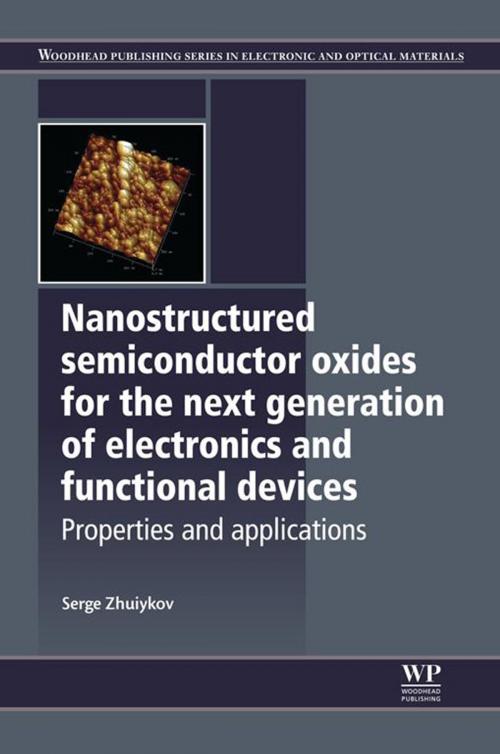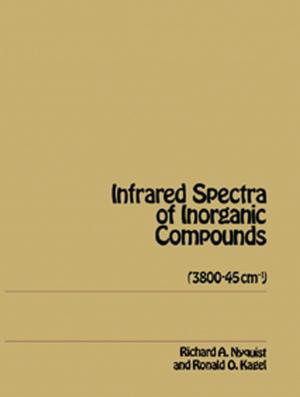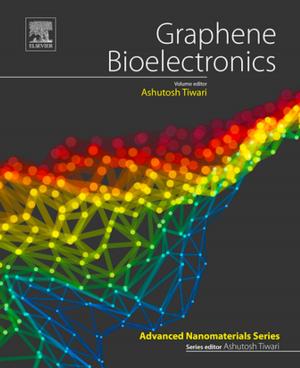Nanostructured Semiconductor Oxides for the Next Generation of Electronics and Functional Devices
Properties and Applications
Nonfiction, Science & Nature, Technology, Electronics, Semiconductors, Science, Physics, Quantum Theory| Author: | Serge Zhuiykov | ISBN: | 9781782422242 |
| Publisher: | Elsevier Science | Publication: | February 14, 2014 |
| Imprint: | Woodhead Publishing | Language: | English |
| Author: | Serge Zhuiykov |
| ISBN: | 9781782422242 |
| Publisher: | Elsevier Science |
| Publication: | February 14, 2014 |
| Imprint: | Woodhead Publishing |
| Language: | English |
Nanostructured Semiconductor Oxides for the Next Generation of Electronics and Functional Devices focuses on the development of semiconductor nanocrystals, their technologies and applications, including energy harvesting, solar cells, solid oxide fuel cells, and chemical sensors. Semiconductor oxides are used in electronics, optics, catalysts, sensors, and other functional devices. In their 2D form, the reduction in size confers exceptional properties, useful for creating faster electronics and more efficient catalysts.
After explaining the physics affecting the conductivity and electron arrangement of nanostructured semiconductors, the book addresses the structural and chemical modification of semiconductor nanocrystals during material growth. It then covers their use in nanoscale functional devices, particularly in electronic devices and carbon nanotubes. It explores the impact of 2D nanocrystals, such as graphene, chalcogenides, and oxide nanostructures, on research and technology, leading to a discussion of incorporating graphene and semiconductor nanostructures into composites for use in energy storage. The final three chapters focus on the applications of these functional materials in photovoltaic cells, solid oxide fuel cells, and in environmental sensors including pH, dissolved oxygen, dissolved organic carbon, and dissolved metal ion sensors.
Nanostructured Semiconductor Oxides for the Next Generation of Electronics and Functional Devices is a crucial resource for scientists, applied researchers, and production engineers working in the fabrication, design, testing, characterization, and analysis of new semiconductor materials. This book is a valuable reference for those working in the analysis and characterization of new nanomaterials, and for those who develop technologies for practical devices fabrication.
- Focuses on the development of semiconductor nanocrystals, their technologies and applications, including energy harvesting, solar cells, solid oxide fuel cells, and chemical sensors
- Reviews fundamental physics of conductivity and electron arrangement before proceeding to practical applications
- A vital resource for applied researchers and production engineers working with new semiconductor materials
Nanostructured Semiconductor Oxides for the Next Generation of Electronics and Functional Devices focuses on the development of semiconductor nanocrystals, their technologies and applications, including energy harvesting, solar cells, solid oxide fuel cells, and chemical sensors. Semiconductor oxides are used in electronics, optics, catalysts, sensors, and other functional devices. In their 2D form, the reduction in size confers exceptional properties, useful for creating faster electronics and more efficient catalysts.
After explaining the physics affecting the conductivity and electron arrangement of nanostructured semiconductors, the book addresses the structural and chemical modification of semiconductor nanocrystals during material growth. It then covers their use in nanoscale functional devices, particularly in electronic devices and carbon nanotubes. It explores the impact of 2D nanocrystals, such as graphene, chalcogenides, and oxide nanostructures, on research and technology, leading to a discussion of incorporating graphene and semiconductor nanostructures into composites for use in energy storage. The final three chapters focus on the applications of these functional materials in photovoltaic cells, solid oxide fuel cells, and in environmental sensors including pH, dissolved oxygen, dissolved organic carbon, and dissolved metal ion sensors.
Nanostructured Semiconductor Oxides for the Next Generation of Electronics and Functional Devices is a crucial resource for scientists, applied researchers, and production engineers working in the fabrication, design, testing, characterization, and analysis of new semiconductor materials. This book is a valuable reference for those working in the analysis and characterization of new nanomaterials, and for those who develop technologies for practical devices fabrication.
- Focuses on the development of semiconductor nanocrystals, their technologies and applications, including energy harvesting, solar cells, solid oxide fuel cells, and chemical sensors
- Reviews fundamental physics of conductivity and electron arrangement before proceeding to practical applications
- A vital resource for applied researchers and production engineers working with new semiconductor materials















